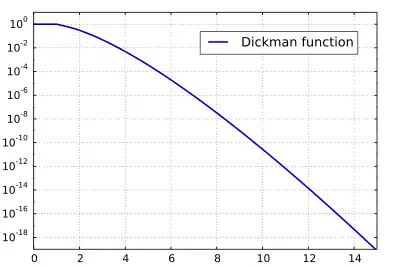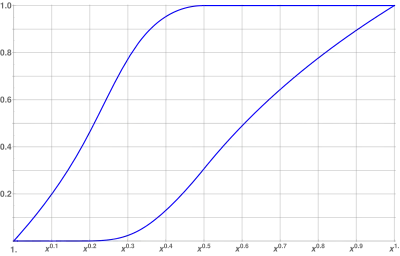Dickman function
In analytic number theory, the Dickman function or Dickman–de Bruijn function ρ is a special function used to estimate the proportion of smooth numbers up to a given bound. It was first studied by actuary Karl Dickman, who defined it in his only mathematical publication,[1] and later studied by the Dutch mathematician Nicolaas Govert de Bruijn.[2][3]

Definition
The Dickman–de Bruijn function is a continuous function that satisfies the delay differential equation
with initial conditions for 0 ≤ u ≤ 1.
Properties
Dickman proved that, when is fixed, we have
where is the number of y-smooth (or y-friable) integers below x.
Ramaswami later gave a rigorous proof that for fixed a, was asymptotic to , with the error bound
Applications

The main purpose of the Dickman–de Bruijn function is to estimate the frequency of smooth numbers at a given size. This can be used to optimize various number-theoretical algorithms such as P-1 factoring and can be useful of its own right.
It can be shown using that[5]
which is related to the estimate below.
The Golomb–Dickman constant has an alternate definition in terms of the Dickman–de Bruijn function.
Estimation
A first approximation might be A better estimate is[6]
where Ei is the exponential integral and ξ is the positive root of
A simple upper bound is
| 1 | 1 |
| 2 | 3.0685282×10−1 |
| 3 | 4.8608388×10−2 |
| 4 | 4.9109256×10−3 |
| 5 | 3.5472470×10−4 |
| 6 | 1.9649696×10−5 |
| 7 | 8.7456700×10−7 |
| 8 | 3.2320693×10−8 |
| 9 | 1.0162483×10−9 |
| 10 | 2.7701718×10−11 |
Computation
For each interval [n − 1, n] with n an integer, there is an analytic function such that . For 0 ≤ u ≤ 1, . For 1 ≤ u ≤ 2, . For 2 ≤ u ≤ 3,
with Li2 the dilogarithm. Other can be calculated using infinite series.[7]
An alternate method is computing lower and upper bounds with the trapezoidal rule;[6] a mesh of progressively finer sizes allows for arbitrary accuracy. For high precision calculations (hundreds of digits), a recursive series expansion about the midpoints of the intervals is superior.[8]
Extension
Friedlander defines a two-dimensional analog of .[9] This function is used to estimate a function similar to de Bruijn's, but counting the number of y-smooth integers with at most one prime factor greater than z. Then
See also
- Buchstab function, a function used similarly to estimate the number of rough numbers, whose convergence to is controlled by the Dickman function
- Golomb–Dickman constant
References
- Dickman, K. (1930). "On the frequency of numbers containing prime factors of a certain relative magnitude". Arkiv för Matematik, Astronomi och Fysik. 22A (10): 1–14.
- de Bruijn, N. G. (1951). "On the number of positive integers ≤ x and free of prime factors > y" (PDF). Indagationes Mathematicae. 13: 50–60.
- de Bruijn, N. G. (1966). "On the number of positive integers ≤ x and free of prime factors > y, II" (PDF). Indagationes Mathematicae. 28: 239–247.
- Ramaswami, V. (1949). "On the number of positive integers less than and free of prime divisors greater than xc" (PDF). Bulletin of the American Mathematical Society. 55 (12): 1122–1127. doi:10.1090/s0002-9904-1949-09337-0. MR 0031958.
- Hildebrand, A.; Tenenbaum, G. (1993). "Integers without large prime factors" (PDF). Journal de théorie des nombres de Bordeaux. 5 (2): 411–484. doi:10.5802/jtnb.101.
- van de Lune, J.; Wattel, E. (1969). "On the Numerical Solution of a Differential-Difference Equation Arising in Analytic Number Theory". Mathematics of Computation. 23 (106): 417–421. doi:10.1090/S0025-5718-1969-0247789-3.
- Bach, Eric; Peralta, René (1996). "Asymptotic Semismoothness Probabilities" (PDF). Mathematics of Computation. 65 (216): 1701–1715. doi:10.1090/S0025-5718-96-00775-2.
- Marsaglia, George; Zaman, Arif; Marsaglia, John C. W. (1989). "Numerical Solution of Some Classical Differential-Difference Equations". Mathematics of Computation. 53 (187): 191–201. doi:10.1090/S0025-5718-1989-0969490-3.
- Friedlander, John B. (1976). "Integers free from large and small primes". Proc. London Math. Soc. 33 (3): 565–576. doi:10.1112/plms/s3-33.3.565.
Further reading
- Broadhurst, David (2010). "Dickman polylogarithms and their constants". arXiv:1004.0519 [math-ph].
- Soundararajan, Kannan (2012). "An asymptotic expansion related to the Dickman function". Ramanujan Journal. 29 (1–3): 25–30. arXiv:1005.3494. doi:10.1007/s11139-011-9304-3. MR 2994087.
- Weisstein, Eric W. "Dickman function". MathWorld.